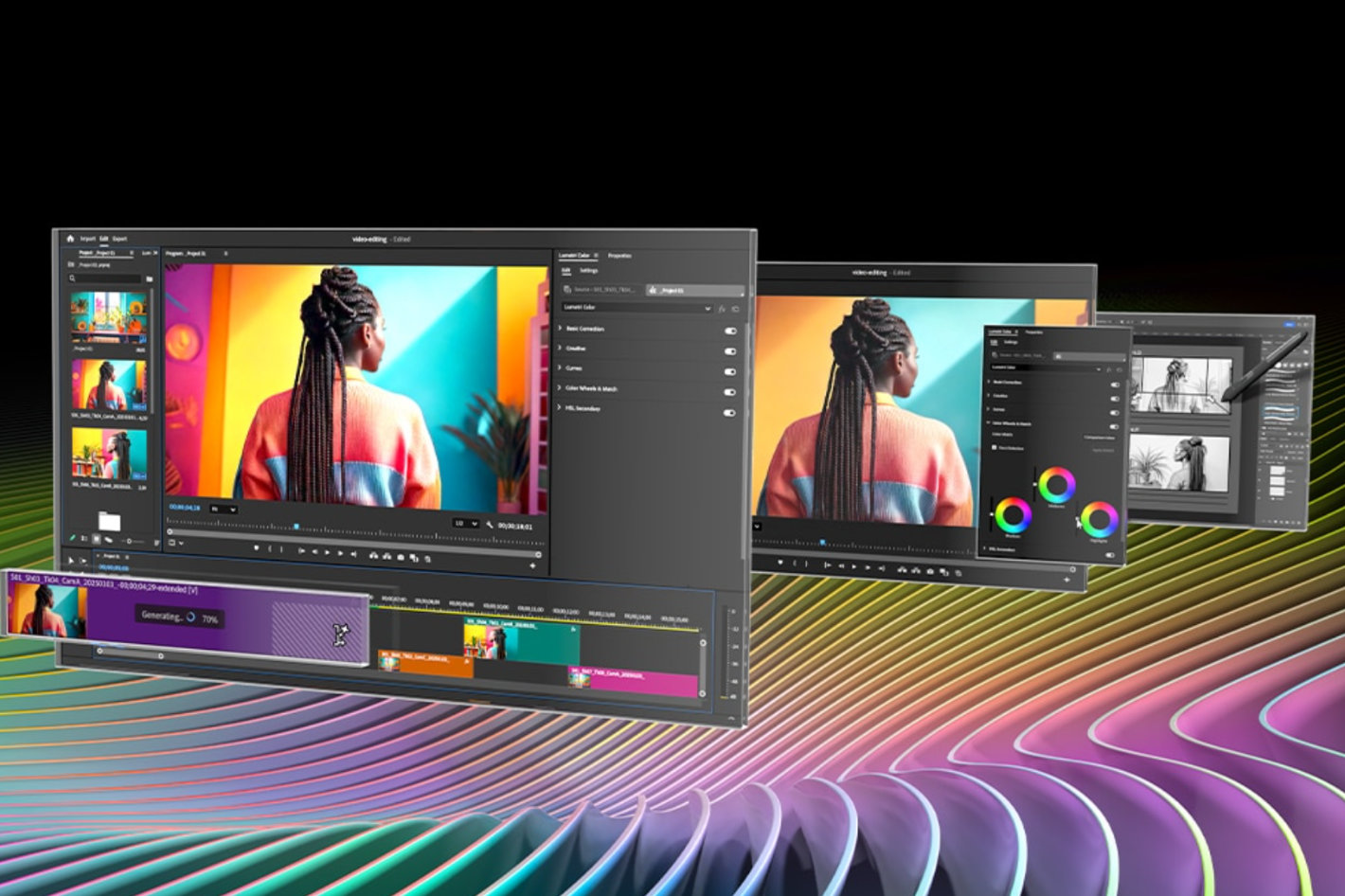 NVIDIA is collaborating with Adobe Premiere Pro, Blackmagic Design’s DaVinci Resolve, Capcut and Wondershare Filmora to integrate the new technologies announced for the RTX 50 series, starting in February.
NVIDIA is collaborating with Adobe Premiere Pro, Blackmagic Design’s DaVinci Resolve, Capcut and Wondershare Filmora to integrate the new technologies announced for the RTX 50 series, starting in February.
Announced as the most advanced consumer GPUs for gamers, creators and developers, the GeForce RTX 50 series desktop and laptop GPUs was finally revealed at CES 2025, during a keynote by Jensen Huang, founder and CEO of NVIDIA. He said that “Blackwell, the engine of AI, has arrived for PC gamers, developers and creatives” adding that “fusing AI-driven neural rendering and ray tracing, Blackwell is the most significant computer graphics innovation since we introduced programmable shading 25 years ago.
Powered by the NVIDIA Blackwell architecture, fifth-generation Tensor Cores and fourth-generation RT Cores, the GeForce RTX 50 Series delivers, according to NVIDIA “breakthroughs in AI-driven rendering, including neural shaders, digital human technologies, geometry and lighting.” The new GPUs are poised to power the next era of generative and agentic AI content creation — offering new tools and capabilities for video, livestreaming, 3D and more.
 Advanced video editing and livestreaming
Advanced video editing and livestreaming
The GeForce RTX 50 Series GPUs can run creative generative AI models up to 2x faster in a smaller memory footprint, compared with the previous generation. They feature ninth-generation NVIDIA encoders for advanced video editing and livestreaming, and come with NVIDIA DLSS 4 and up to 32GB of VRAM to tackle massive 3D projects. These GPUs come with various software updates, including two new AI-powered NVIDIA Broadcast effects, updates to RTX Video and RTX Remix, and NVIDIA NIM microservices — prepackaged and optimized models built to jumpstart AI content creation workflows on RTX AI PCs.
NVIDIA says that the GeForce RTX 50 Series GPUs “deliver a generational leap in NVIDIA encoders and decoders with support for the 4:2:2 pro-grade color format, multiview-HEVC (MV-HEVC) for 3D and virtual reality (VR) video, and the new AV1 Ultra High Quality mode.”
Most consumer cameras are confined to 4:2:0 color compression, which reduces the amount of color information. 4:2:0 is typically sufficient for video playback on browsers, but it can’t provide the color depth needed for advanced video editors to color grade videos. The 4:2:2 format provides double the color information with just a 1.3x increase in RAW file size — offering an ideal balance for video editing workflows.
Decoding 4:2:2 video can be challenging due to the increased file sizes. GeForce RTX 50 Series GPUs include 4:2:2 hardware support that can decode up to eight times the 4K 60 frames per second (fps) video sources per decoder, enabling smooth multi-camera video editing.
The GeForce RTX 5090 GPU is equipped with three encoders and two decoders, the GeForce RTX 5080 GPU includes two encoders and two decoders, the 5070 Ti GPUs has two encoders with a single decoder, and the GeForce RTX 5070 GPU includes a single encoder and decoder. These multi-encoder and decoder setups, paired with faster GPUs, enable the GeForce RTX 5090 to export video 60% faster than the GeForce RTX 4090 and at 4x speed compared with the GeForce RTX 3090.
GeForce RTX 50 Series GPUs also feature the ninth-generation NVIDIA video encoder, NVENC, that offers a 5% improvement in video quality on HEVC and AV1 encoding (BD-BR), as well as a new AV1 Ultra Quality mode that achieves 5% more compression at the same quality. They also include the sixth-generation NVIDIA decoder, with 2x the decode speed for H.264 video.
NVIDIA is collaborating with Adobe Premiere Pro, Blackmagic Design’s DaVinci Resolve, Capcut and Wondershare Filmora to integrate these technologies, starting in February.
3D video is starting to catch on thanks to the growth of VR, AR and mixed reality headsets. The new RTX 50 Series GPUs also come with support for MV-HEVC codecs to unlock such formats in the near future.
 For desktop and laptops
For desktop and laptops
For desktop users, the GeForce RTX 5090 GPU with 3,352 AI TOPS and the GeForce RTX 5080 GPU with 1,801 AI TOPS will be available on Jan. 30 at $1,999 and $999, respectively.
The GeForce RTX 5070 Ti GPU with 1,406 AI TOPS and GeForce RTX 5070 GPU with 988 AI TOPS – which according to Jensen Huang delivers the performance of a RTX 4090 for nearly a third of the price – will be available starting in February at $749 and $549, respectively.
The NVIDIA Founders Editions of the GeForce RTX 5090, RTX 5080 and RTX 5070 GPUs will be available directly from nvidia.com and select retailers worldwide.
Stock-clocked and factory-overclocked models will be available from top add-in card providers such as ASUS, Colorful, Gainward, GALAX, GIGABYTE, INNO3D, KFA2, MSI, Palit, PNY and ZOTAC, and in desktops from system builders including Falcon Northwest, Infiniarc, MAINGEAR, Mifcom, ORIGIN PC, PC Specialist and Scan Computers.
Laptops with GeForce RTX 5090, RTX 5080 and RTX 5070 Ti Laptop GPUs will be available starting in March, and RTX 5070 Laptop GPUs will be available starting in April from the world’s top manufacturers, including Acer, ASUS, Dell, GIGABYTE, HP, Lenovo, MECHREVO, MSI and Razer.

Filmtools
Filmmakers go-to destination for pre-production, production & post production equipment!
Shop Now













